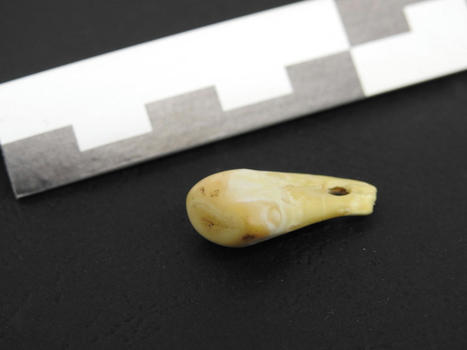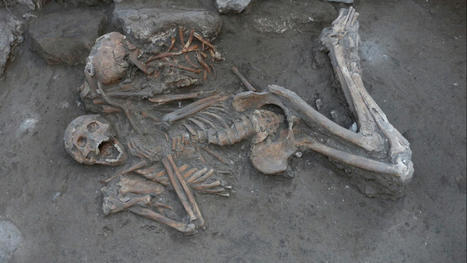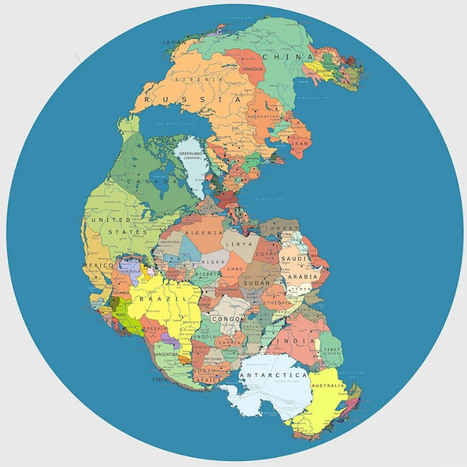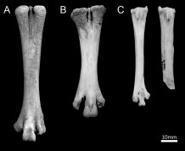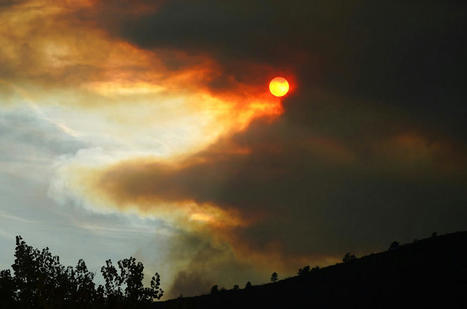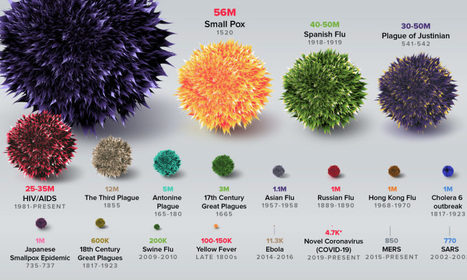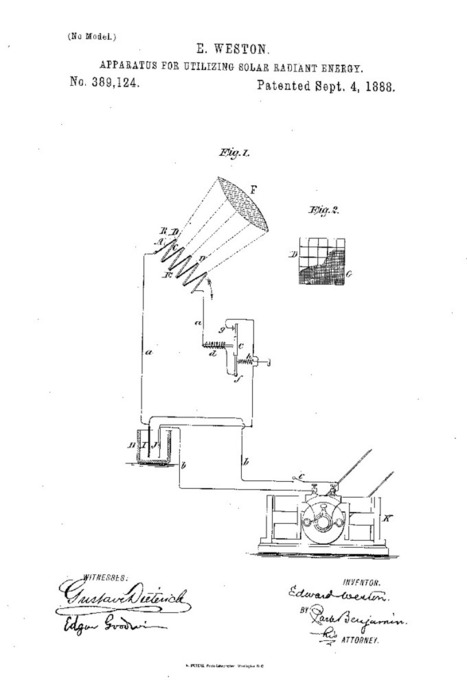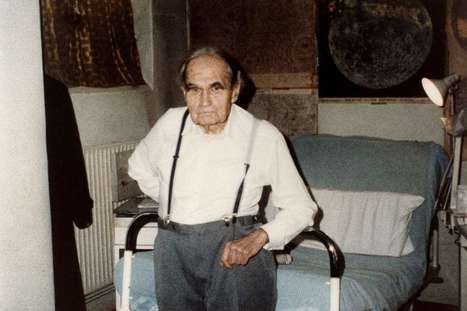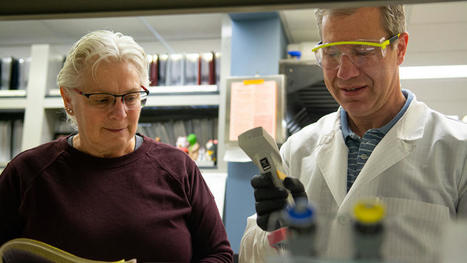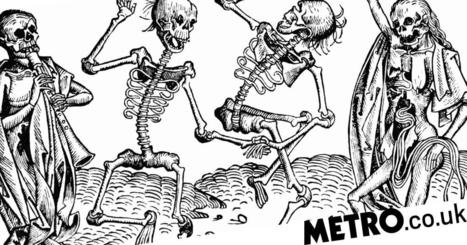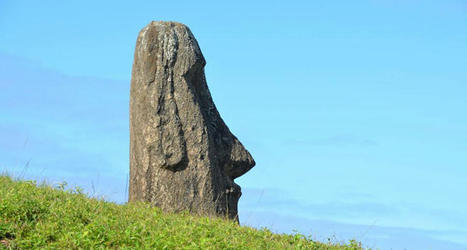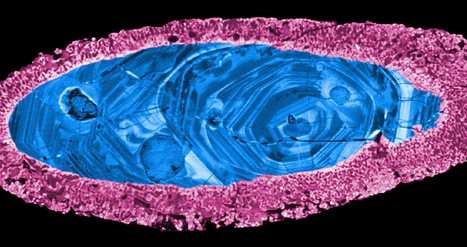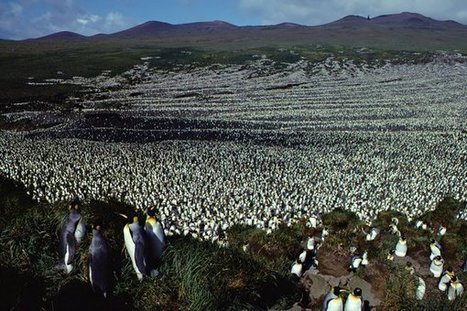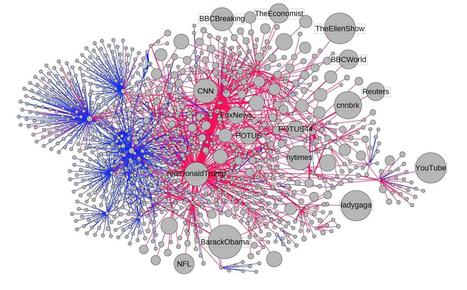 Your new post is loading...
In total 12 people have walked on the moon. Neil Armstrong made history by becoming the first person to set foot on the moon. 1 + 2. Apollo 11 - July 21, 1969 Neil Armstrong made history by becoming the first person to set foot on the lunar surface, before he he was followed by crewmate Edwin 'Buzz' Aldrin. 3 + 4. Apollo 12 - November 19 and 20, 1969 Pete Conrad and Alan Bean were the moon walkers on the Apollo 12 mission. The Apollo 12 crew experienced two lightning strikes just after their Saturn V rocket launched. 5 + 6. Apollo 14 - February 5, 1971 Alan Shepard and Edgar Mitchell were part of the Apollo 14 mission. They launched on January 31, 1971, and landed in the Fra Mauro region of the moon, the original destination for Apollo 13. 7 + 8. Apollo 15 - July 31, 1971 Dave Scott and James Irwin landed on the moon and stayed for three days, until August 2. 9 + 10. Apollo 16 - April 21, 1972 John Young and Charlie Duke were the next men to walk on the moon. When the crew reached lunar orbit, the mission almost had to be aborted because of a problem with the command and service module's main engine. 11 + 12. Apollo 17 - December 11, 1972 The final people to walk on the moon were Eugene (Gene) Cernan and Harrison (Jack) Schmitt. Before he left the moon, Cernan scratched the initials of his daughter Tracy into the lunar regolith. Since the moon does not experience weather conditions like wind or rain to erode anything away, her initials should stay there for a very long time.
An international research team led by the Max Planck Institute for Evolutionary Anthropology in Leipzig, Germany, has for the first time successfully isolated ancient human DNA from a Paleolithic artefact: a pierced deer tooth discovered in Denisova Cave in southern Siberia. To preserve the integrity of the artefact, they developed a new, nondestructive method for isolating DNA from ancient bones and teeth. From the DNA retrieved they were able to reconstruct a precise genetic profile of the woman who used or wore the pendant, as well as of the deer from which the tooth was taken. Genetic dates obtained for the DNA from both the woman and the deer show that the pendant was made between 19,000 and 25,000 years ago. The tooth remains fully intact after analysis, providing testimony to a new era in ancient DNA research, in which it may become possible to directly identify the users of ornaments and tools produced in the deep past. Pierced deer tooth discovered from Denisova Cave in southern Siberia that yielded ancient human DNA. Artefacts made of stone, bones or teeth provide important insights into the subsistence strategies of early humans, their behavior and culture. However, until now it has been difficult to attribute these artefacts to specific individuals, since burials and grave goods were very rare in the Palaeolithic. This has limited the possibilities of drawing conclusions about, for example, division of labor or the social roles of individuals during this period. In order to directly link cultural objects to specific individuals and thus gain deeper insights into Paleolithic societies, an international, interdisciplinary research team, led by the Max Planck Institute for Evolutionary Anthropology in Leipzig, has developed a novel, non-destructive method for DNA isolation from bones and teeth. Although they are generally rarer than stone tools, the scientists focused specifically on artefacts made from skeletal elements, because these are more porous and are therefore more likely to retain DNA present in skin cells, sweat and other body fluids. A new DNA extraction method Lead author Elena Essel working in the clean laboratory on the pierced deer tooth discovered from Denisova Cave. Before the team could work with real artefacts, they first had to ensure that the precious objects would not be damaged. “The surface structure of Paleolithic bone and tooth artefacts provides important information about their production and use. Therefore, preserving the integrity of the artefacts, including microstructures on their surface, was a top priority” says Marie Soressi, an archaeologist from the University of Leiden who supervised the work together with Matthias Meyer, a Max Planck geneticist. The team tested the influence of various chemicals on the surface structure of archaeological bone and tooth pieces and developed a non-destructive phosphate-based method for DNA extraction. “One could say we have created a washing machine for ancient artifacts within our clean laboratory," explains Elena Essel, the lead author of the study who developed the method. "By washing the artifacts at temperatures of up to 90°C, we are able to extract DNA from the wash waters, while keeping the artifacts intact.”
A recent excavation in Megiddo, Israel, unearthed the earliest example of a particular type of cranial surgery in the Ancient Near East — and potentially one of the oldest examples of leprosy in the world. Archaeologists know that people have practiced cranial trephination, a medical procedure that involves cutting a hole in the skull, for thousands of years. They've turned up evidence that ancient civilizations across the globe, from South America to Africa and beyond, performed the surgery. Now, thanks to a recent excavation at the ancient city of Megiddo, Israel, there's new evidence that one particular type of trephination dates back to at least the late Bronze Age. Rachel Kalisher, a Ph.D. candidate at Brown University's Joukowsky Institute for Archaeology and the Ancient World, led an analysis of the excavated remains of two upper-class brothers who lived in Megiddo around the 15th century B.C. She found that not long before one of the brothers died, he had undergone a specific type of cranial surgery called angular notched trephination. The procedure involves cutting the scalp, using an instrument with a sharp beveled edge to carve four intersecting lines in the skull, and using leverage to make a square-shaped hole. Kalisher said the trephination is the earliest example of its kind found in the Ancient Near East. "We have evidence that trephination has been this universal, widespread type of surgery for thousands of years," Kalisher said. "But in the Near East, we don't see it so often -- there are only about a dozen examples of trephination in this entire region. My hope is that adding more examples to the scholarly record will deepen our field's understanding of medical care and cultural dynamics in ancient cities in this area." Kalisher's analysis, written in collaboration with scholars in New York, Austria and Israel, was published on Wednesday, Feb. 22, in PLOS ONE.
About 300 million years ago, Earth didn't have seven continents, but instead one massive supercontinent called Pangea, which was surrounded by a single large ocean called Panthalassa. The explanation for Pangea's formation ushered in the modern theory of plate tectonics, which posits that the Earth's outer shell is broken up into several plates that slide over Earth's rocky shell, the mantle. Over the course of the planet's 4.5 billion-year history, several supercontinents have formed and broken up, a result of churning and circulation in the Earth's mantle, which makes up 84% of the planet's volume, according to the U.S. Geological Survey. This breakup and formation of supercontinents has dramatically altered the planet's history. "This is what's driven the entire evolution of the planet through time. This is the major backbeat of the planet," said Brendan Murphy, a geology professor at the St. Francis Xavier University, in Antigonish, Nova Scotia. PANGEA'S HISTORY More than a century ago, the scientist Alfred Wegener proposed the notion of an ancient supercontinent, which he named Pangea, after putting together several lines of evidence. The first and most obvious was that the "continents fit together like a tongue and groove," something that was quite noticeable on any accurate map, Murphy said. Another telltale hint that Earth's continents were all one land mass comes from the geologic record. Coal deposits found in Pennsylvania have a similar composition to those spanning across Poland, Great Britain and Germany from the same time period. That indicates that North America and Europe must have once been a single landmass. And the orientation of magnetic minerals in geologic sediments reveals how Earth's magnetic poles migrated over geologic time, Murphy said. In the fossil record, identical plants, such as the extinct seed fern Glossopteris, are found on now widely disparate continents. And mountain chains that now lie on different continents, such as the Appalachians in the United States and the Atlas Mountains spanning Morocco, Algeria and Tunisia were all part of the Central Pangaea Mountains, formed through the collision of the supercontinents Gondwana and Laurussia.
New research transforms our understanding of the circumstances and timing of the domestication of chickens, their spread across Asia into the west, and reveals the changing way in which they were perceived in societies over the past 3,500 years. Experts have found that an association with rice farming likely started a process that has led to chickens becoming one of the world's most numerous animals. They have also found evidence that chickens were initially regarded as exotica, and only several centuries later used as a source of 'food'. Previous efforts have claimed that chickens were domesticated up to 10,000 years ago in China, Southeast Asia, or India, and that chickens were present in Europe over 7,000 years ago. The new studies show this is wrong, and that the driving force behind chicken domestication was the arrival of dry rice farming into southeast Asia where their wild ancestor, the red jungle fowl, lived. Dry rice farming acted as a magnet drawing wild jungle fowl down from the trees, and kickstarting a closer relationship between people and the jungle fowl that resulted in chickens. This domestication process was underway by around 1,500 BC in the Southeast Asia peninsula. The research suggests that chickens were then transported first across Asia and then throughout the Mediterranean along routes used by early Greek, Etruscan and Phoenician maritime traders. During the Iron Age in Europe, chickens were venerated and generally not regarded as food. The studies have shown that several of the earliest chickens are buried alone and un-butchered, and many are also found buried with people. Males were often buried with cockerels and females with hens. The Roman Empire then helped to popularise chickens and eggs as food. For example, in Britain, chickens were not regularly consumed until the third century AD, mostly in urban and military sites. The international research team re-evaluated chicken remains found in more than 600 sites in 89 countries. They examined the skeletons, burial location and historical records regarding the societies and cultures where the bones were found. The oldest bones of a definite domestic chicken were found at Neolithic Ban Non Wat in central Thailand, and date to between 1,650 and 1,250 BC. The team of experts also used radiocarbon dating to establish the age of 23 of the proposed earliest chickens found in western Eurasia and north-west Africa. Most of the bones were far more recent than previously thought. The results dispel claims of chickens in Europe before the first millennium BC and indicate that they did not arrive until around 800 BC. Then, after arriving in the Mediterranean region, it took almost 1,000 years longer for chickens to become established in the colder climates of Scotland, Ireland, Scandinavia and Iceland.
You wake up to a dark, dreary, glum-feeling, Monday-type of morning. For the 547th consecutive day. Just 18 months prior, you were a hard-working farmer gearing up for another bountiful crop season. But then the skies went dark. And they stayed dark -- day after day, month after month -- from early 536 to 537. Across much of eastern Europe and throughout Asia, spring turned into summer and fall gave way to winter without a day of sunshine. Like a blackout curtain over the sun, millions of people across the world's most populated countries squinted through dim conditions, breathing in chokingly thick air and losing nearly every crop they were relying on to harvest. This isn't the plot of a dystopian TV drama or a fantastical "docu-fiction" production. This was a harsh reality for the millions of people who lived through that literally dark time or, as some historians have declared, the very worst year ever to be alive. The darkest year ahead of the darkest decade "For the sun gave forth its light without brightness, like the moon, during this whole year, and it seemed exceedingly like the sun in eclipse, for the beams it shed were not clear nor such as it is accustomed to shed," was the grim account Procopius, a prominent scholar who became the principal Byzantine historian of the 6th century, gave in History of the Wars. "And from the time when this thing happened men were free neither from war nor pestilence nor any other thing leading to death." Some 1,500 years later, Harvard University medieval historian Michael McCormick has reached a similarly grim conclusion about not just 536, but the dreadful decade that followed that terrible year. For people living across Europe in 536, "It was the beginning of one of the worst periods to be alive, if not the worst year," McCormick said. As McCormick told AccuWeather, it was all set off by rapid, drastic climate change. In the spring of 536, a volcanic eruption triggered the Late Antique Little Ice Age (LALIA), he noted. And its ramifications, on top of ensuing eruptions in 540 and 547, were devastating. "Aerosols for the big volcanic eruptions blocked solar radiation, dropping the solar heating of the Earth’s surface," he explained, adding that climate analysis from Cambridge University in the U.K. done on tree rings show the average summer temperature "dropped by between 1.5 degrees and 2.5 degrees Celsius across Eurasia." That's up to 2.7 to 4.5 degrees Fahrenheit cooler due to the heavy smog left behind after the eruption. The skies remained dimmed for up to 18 months, multiple historical witnesses recounted, triggering the dark year of turmoil that earned 536 its dubious distinction. Weather patterns were severely affected by the blocked sunlight, leading to summer snowfall in China and the lowest temperature levels in more than 2,300 years, according to recorded historical accounts and climate reconstruction analysis. In the Middle East, China and Europe, a dense fog was an inescapable daily nightmare while widespread agricultural challenges in Ireland resulted in a "failure of bread from the years 536–539 AD," according to The Gaelic Irish Annals.
Over the last few decades, life expectancy has increased dramatically around the globe. The average person born in 1960, the earliest year the United Nations began keeping global data, could expect to live to 52.5 years of age. Today, the average is 72. In the UK, where records have been kept longer, this trend is even greater. In 1841, a baby girl was expected to live to just 42 years of age, a boy to 40. In 2016, a baby girl could expect to reach 83; a boy, 79. The natural conclusion is that both the miracles of modern medicine and public health initiatives have helped us live longer than ever before – so much so that we may, in fact, be running out of innovations to extend life further. In September 2018, the Office for National Statistics confirmed that, in the UK at least, life expectancy has stopped increasing. Beyond the UK, these gains are slowing worldwide. This belief that our species may have reached the peak of longevity is also reinforced by some myths about our ancestors: it’s common belief that ancient Greeks or Romans would have been flabbergasted to see anyone above the age of 50 or 60, for example. In fact, while medical advancements have improved many aspects of healthcare, the assumption that human life span has increased dramatically over centuries or millennia is misleading. Overall life expectancy, which is the statistic reflected in reports like those above, hasn’t increased so much because we’re living far longer than we used to as a species. It’s increased because more of us, as individuals, are making it that far.
“There is a basic distinction between life expectancy and life span,” says Stanford University historian Walter Scheidel, a leading scholar of ancient Roman demography. “The life span of humans – opposed to life expectancy, which is a statistical construct – hasn’t really changed much at all, as far as I can tell.”
Life expectancy is an average. If you have two children, and one dies before their first birthday but the other lives to the age of 70, their average life expectancy is 35. That’s mathematically correct – and it certainly tells us something about the circumstances in which the children were raised. But it doesn’t give us the full picture. It also becomes especially problematic when looking at eras, or in regions, where there are high levels of infant mortality. Most of human history has been blighted by poor survival rates among children, and that continues in various countries today. This averaging-out, however, is why it’s commonly said that ancient Greeks and Romans, for example, lived to just 30 or 35. But was that really the case for people who survived the fragile period of childhood, and did it mean that a 35-year-old was truly considered ‘old’? If one’s thirties were a decrepit old age, ancient writers and politicians don’t seem to have got the message. In the early 7th Century BC, the Greek poet Hesiod wrote that a man should marry “when you are not much less than 30, and not much more”. Meanwhile, ancient Rome’s ‘cursus honorum’ – the sequence of political offices that an ambitious young man would undertake – didn’t even allow a young man to stand for his first office, that of quaestor, until the age of 30 (under Emperor Augustus, this was later lowered to 25; Augustus himself died at 75). To be consul, you had to be 43 – eight years older than the US’s minimum age limit of 35 to hold a presidency. In the 1st Century, Pliny devoted an entire chapter of The Natural History to people who lived longest. Among them he lists the consul M Valerius Corvinos (100 years), Cicero’s wife Terentia (103), a woman named Clodia (115 – and who had 15 children along the way), and the actress Lucceia who performed on stage at 100 years old.
Explore the history of computers + micro-electronics technology at the virtual museum called Chips etc. — 1,000 rare parts from the world’s foremost electronics + semi-conductor companies. People from every generation have a fascination with the evolution of computers: whether it’s chips, computer hardware, or ephemera. Both specialists and amateurs — hobbyist, makers, historians, engineers, and scientists — enjoy vintage computer parts. Since computing first began in the 20th century, the field has been progressing in leaps + bounds — making these historic markers of the past even more interesting. It’s always an intriguing and valuable lesson to see how we got from the past to where we are today. This is especially true watching the development of computers. For example: an old Apple II computer made by Apple from years 1977 — 1993. Once ubiquitous in school classrooms in the 1980s, the Apple II is now functionally useless: except for helping us understand Apple’s re-emergence as a huge brand in personal computing. Apple’s early computers sparked trends in design, craftsmanship, and applications that set the stage for modern laptops, desktops, smartphones, and tablets. What is rare is intriguing. People are fascinated by antiques, it’s a special experience to touch artifacts from the past, and bring history to life. As we approach year 2020, vintage electronic components are becoming rare. Old computer parts continue to be melted down for their scrap gold content by precious metal recyclers. With only a few thousand in the world — collectors and museums are essential to preserving our technological past. Some dedicated curators manage large collections that are now highly valuable, as vintage electronics items age: from yesterday’s junk — to today’s hard-to-find, coveted antiquities.
Over time, infectious diseases have been humanity's constant companion. This infographic visualizes the history of pandemics throughout times, from the Antonine Plague to COVID-19.
Inventors have been advancing solar technology for more than a century and a half, and improvements in efficiency and aesthetics keep on coming. Long before the first Earth Day was celebrated on April 22, 1970, generating awareness about the environment and support for environmental protection, scientists were making the first discoveries in solar energy. It all began with Edmond Becquerel, a young physicist working in France, who in 1839 observed and discovered the photovoltaic effect— a process that produces a voltage or electric current when exposed to light or radiant energy. A few decades later, French mathematician Augustin Mouchot was inspired by the physicist’s work. He began registering patents for solar-powered engines in the 1860s. From France to the U.S., inventors were inspired by the patents of the mathematician and filed for patents on solar-powered devices as early as 1888.
Adolf Hitler's deputy flew to Scotland in 1941 and was imprisoned for the rest of his life. But was the man in Spandau really Rudolf Hess? Now a DNA test has revealed the truth The Deputy Führer of the Third Reich Rudolf Hess was captured after a controversial flight to Scotland in 1941. Hess was sentenced to life imprisonment during the Nuremberg War Crimes Trials. He was detained in Berlin’s Spandau Prison under the official security designation ‘Spandau #7.’ Early doubts arose about the true identity of prisoner ‘Spandau #7.’ This evolved to a frequently espoused conspiracy theory that prisoner ‘Spandau #7’ was an imposter and not Rudolf Hess. After Hess’s reputed 1987 suicide, the family grave became a Neo-Nazi pilgrimage site. In 2011, the grave was abandoned and the family remains cremated. Here scientists now report the forensic DNA analysis of the only known extant DNA sample from prisoner ‘Spandau #7’ and a match to the Hess male family line, thereby refuting the Doppelgänger Theory. The prisoner in Spandau #7 was indeed Rudolf Hess.
In a follow-up to their groundbreaking study, Baylor researchers were able to reconstruct baleen whales' lifetime stress response to whaling and other manmade and environmental factors spanning nearly 150 years. Using a technique they pioneered six years ago, Stephen J. Trumble, Ph.D., associate professor of biology, and Sascha Usenko, Ph.D., associate professor of environmental science, both in Baylor University's College of Arts & Sciences, analyzed earplug laminae, a growth layer representing six months found in whale earwax, as part of their recent study published in Nature Communications this month. Using earplugs taken from fin, humpback and blue whales originating in the Pacific and Atlantic Oceans from 1870 to 2016, Trumble and Usenko were able to determine the whales' cortisol levels, a stress-response hormone, to industrial whaling, World War II wartime activities and sea-surface temperature. "This is the first-ever study to quantify temporal stress patterns in baleen whales," Trumble said. "While the generated stress profile spans nearly 150 years, we show that these whales experienced survivor stress, meaning the exposure to the indirect effects of whaling, including ship noise, ship proximity and constant harassment, results in elevated stress hormones in whales spanning vast distances." Whaling had a significant impact on whales' cortisol levels. During the 1960s when whaling was at its peak with 150,000 whales harvested, cortisol peaked to a maximum and was the highest average in whales in the 20th century, according to the study's findings. During World War II when whaling declined, whales still showed an increase in cortisol levels. Trumble and Usenko suggest the impact of the theater of war. "The stressors associated with activities specific to WWII may supplant the stressors associated with industrial whaling for baleen whales," Usenko said. "We surmised that wartime activities such as under water detonation, naval battles including ships, planes and submarines, as well as increased vessel numbers, contributed to increase cortisol concentrations during this period of reduced whaling." When whaling moratoriums were introduced in the mid-1970s, whaling decreased as well as cortisol levels--reaching their lowest concentrations. "From the 1970s through the 2010s whaling counts were reportedly zero in the Northern Hemisphere, but mean cortisol levels steadily increased, with recent peaks reaching near the maximum levels observed before whaling moratoriums," Usenko said. The impact of stress on whales could have larger implications for baleen whales, which are "considered sentinels of their environment and indicators of anthropogenic or manmade stressors," Usenko said. "This study shows that anthropogenic stressors results in a physiological response in large whales. These chronic stressors may impact life history events such as reproductive parameters," Trumble said. "Lastly, human-based stressors such as warming sea surface temperatures may also result in elevated stress in these whales."
A low level of atmospheric oxygen in Earth's middle ages held back evolution for 2 billion years, raising fresh questions about the origins of life on this planet. New research by the University of Exeter explains how oxygen was trapped at such low levels. Professor Tim Lenton and Dr Stuart Daines of the University of Exeter Geography department, created a computer model to explain how oxygen stabilised at low levels and failed to rise any further, despite oxygen already being produced by early photosynthesis. Their research helps explain why the 'great oxidation event', which introduced oxygen into the atmosphere around 2.4 billion years ago, did not generate modern levels of oxygen. In their paper, published in Nature Communications, Atmospheric oxygen regulation at low Proterozoic levels by incomplete oxidative weathering of sedimentary organic carbon, the University of Exeter scientists explain how organic material -- the dead bodies of simple lifeforms -- accumulated in the earth's sedimentary rocks. After the Great Oxidation, and once plate tectonics pushed these sediments to the surface, they reacted with oxygen in the atmosphere for the first time. The more oxygen in the atmosphere, the faster it reacted with this organic material, creating a regulatory mechanism whereby the oxygen was consumed by the sediments at the same rate at which it was produced. This mechanism broke down with the rise of land plants and a resultant doubling of global photosynthesis. The increasing concentration of oxygen in the atmosphere eventually overwhelmed the control on oxygen and meant it could finally rise to the levels we are used to today. This helped animals colonize the land, leading eventually to the evolution of humankind. The model suggests atmospheric oxygen was likely at around 10% of present day levels during the two billion years following the Great Oxidation Event, and no lower than 1% of the oxygen levels we know today.
|
It's like combining Google Translate with a time machine: - Researchers have unearthed hundreds of thousands of cuneiform tablets, but many remain untranslated.
- Translating an ancient language is a time-intensive process, and only a few hundred experts are qualified to perform it.
- A recent study describes a new AI that produces high-quality translations of ancient texts.
Translation isn’t simply a matter of swapping one word for a corresponding word in another language. A high-quality translation requires the translator to understand how both languages string thoughts together and then use that knowledge to create a translation that maintains the linguistic nuances of the original, which native speakers effortlessly understand. As difficult as that process is, it’s nothing compared to the challenge of translating an ancient language into a modern tongue. These translators must not only resurrect extinct languages from written sources but also have intimate knowledge of how the cultures that produced those sources evolved over centuries. If that weren’t enough, their sources are often fragmented, leaving crucial context lost to the ages. Because of this, the number of people capable of translating languages from antiquity is small, and their best efforts are often outpaced by the volume of texts unearthed by archeologists. Take ancient Akkadian. This early Semitic language is one of the best attested from the ancient world. Hundreds of thousands, by some accounts more than a million, Akkadian texts have been discovered and today lie in museums and universities. Many have even been digitized online. Each one has the potential to teach us about the life, politics, and beliefs of the first civilizations, yet this knowledge remains locked behind the time and manpower necessary to translate them. To help change that, a multidisciplinary team of archaeologists and computer scientists has developed an artificial intelligence that can translate Akkadian almost instantly and unlock the historic record preserved in these 5,000-year-old tablets. Hundreds of thousand of cuneiform tablets are housed in museum and university collections, yet many of these remain untranslated due to how time-intensive the process is and how few people have the expertise to do so. Akkadian lost (and found) Akkadian was the mother tongue of the Akkadian Empire, which arose around 2300 B.C. through the conquests of its founder, Sargon the Great. As a spoken language, Akkadian would eventually split into Assyrian and Babylonian dialects before being completely supplanted by Aramaic early in the first millennium BC. Today, it is a truly extinct language, without even daughter languages to carry on its legacy. As a written language, however, Akkadian proved more enduring. The empire borrowed the cuneiform script of its predecessor, the Sumerian civilization. This writing system used a reed stylus to impress wedge-shaped glyphs into wet clay tablets before baking them (hence the name cuneiform, which literally means “wedge-shaped” in Latin). Even after Aramaic supplanted Akkadian as the common language of the region, scholars continued to write in Akkadian cuneiform into the first century AD — even in antiquity, it seems, scholars and academics were incredibly stubborn. This traditional mindset had an unintended benefit for modern archeologists, too. While cuneiform could be written on papyrus, it was more often scribed onto clay or stone. These materials stand up much better to the fires and floods that ravaged their pithy peers. And while time is cruel to all things — archeologists rarely discover cuneiform tablets in mint condition — this is one reason why Akkadian writing may be so well-attested in the historic record. “Ironically, destructive conflagrations have preserved some of ancient Mesopotamia’s greatest libraries — because they were made of clay. In contrast, all of ancient Egypt’s papyrus libraries have burnt or crumbled to dust, though many individual codices survive,” linguist Steven Roger Fischer writes in A History of Writing. Even with such linguist riches, properly translating these ancient libraries is no small feat. Beyond the challenges already mentioned, the Akkadian language is polyvalent. That is, its cuneiform signs can have several different readings depending on how each one functions in a sentence. There are many reasons for this development, but according to Fischer, one reason the Akkadians never simplified was that they “appeared to be bound to tradition and a self-imposed efficiency.” That traditional mindset led them to continue using Sumerian script for a language very different from Sumerian. As such, translating Akkadian is a two-step process. First, scholars must transliterate the cuneiform signs. That is, they take the cuneiform and rewrite it using the similar-sounding phonetics of the target language. An example most readers will be familiar with is the Arabic word الله, which translates into English as “God” but transliterates as “Allah.” This transliteration is the closest the Latin alphabet can get to producing the word as it sounds in Arabic. Scholars then take their transliteration of the text and translate it into a modern language. Fast-acting AI for instant results As you can imagine, that can be a long and laborious process — one that takes years of training and dedication to learn to do well. To help speed things along, the research team developed a neural machine translation model for Akkadian cuneiform, the same technology under the hood of Google Translate. The team trained the AI model on a sample of cuneiform texts from the Open Richly Annotated Cuneiform Corpus and taught it to translate in two distinct ways. First, the AI model learned to translate Akkadian from transliterations of the original texts. It also learned how to translate cuneiform symbols directly. More specifically, it translated Unicode glyphs of cuneiform texts that were generated by another time-saving tool that automatically produces Unicode from an image of an original tablet. The AI model then had to figure out how to handle the nuances of the sample’s various genres — for example, the difference between literary works and administrative letters — as well as how to handle the changes found in cuneiform script over the millennia it was used. The AI model was then tested using the bilingual evaluation understudy 4 (BLEU4), an algorithm used to appraise machine-translated text. In its transliteration to English test, the team’s AI model scored 37.47. In its cuneiform to English test, it scored 36.52. Both scores were above their target baseline and in the range of a high-quality translation. And there was a surprising result: The model was able to reproduce the nuances of each test sentence’s genre. While this wasn’t one of the researcher’s goals, they note in the study that it may open possibilities for uses beyond translation. “In almost every instance, whether the [translation] is proper or not, the genre is recognizable,” the team writes. “A promising future scenario would have the [model] show the user a list of sources on which they based their translations, which would also be particularly useful for scholarly purposes.” The team published their results in the peer-reviewed PNAS Nexus. They also released their research and source code on GitHub at Akkademia. Although clay and stone tablets may stand up better than papyrus to the ravishes of time, they are often still found fragmented and may be missing crucial context.(Credit: homocosmicos / Adobe Stock) The past’s future looks brighter As promising as the initial results are, there is still work to be done. In both cases, some of the test sentences were mistranslated. And like other AI models, this one is prone to hallucinations — moments where the response has no connection to the source. In one instance, the human translator produced the sentence “Why should we (also) conduct the lawsuit before a man from Libbi-Ali?” The AI’s translation: “They are in the Inner City in the Inner City.” (A bit off.) All told, the AI model works best when it is translating short- to medium-length sentences. It also does better with more formulaic genres, like royal decrees and administrative records, than literary genres such as myths, hymns, and prophecies. With more training on a larger dataset, the researchers note in the study, they aim to improve its accuracy. In time, they hope their AI model can act as a virtual assistant to human scholars. The AI can provide the raw translation quickly, while the scholar can refine it with their knowledge of historic languages, cultures, and people. “Hundreds of thousands of clay tablets inscribed in the cuneiform script document the political, social, economic, and scientific history of ancient Mesopotamia. Yet, most of these documents remain untranslated and inaccessible due to their sheer number and limited quantity of experts able to read them,” the team writes in the study. “This is another major step toward the preservation and dissemination of the cultural heritage of ancient Mesopotamia.”
Via Charles Tiayon
For the first time, scientists now have a continuous model of the the Earth's past 100 million years. This will provide a new tool to understand ocean chemistry and how geomorphology affects biological evolution. Climate, tectonics and time combine to create powerful forces that craft the face of our planet. Add the gradual sculpting of the Earth's surface by rivers and what to us seems solid as rock is constantly changing. However, our understanding of this dynamic process has at best been patchy. Scientists have now published new research revealing a detailed and dynamic model of the Earth's surface over the past 100 million years. Working with scientists in France, University of Sydney geoscientists have published this new model in the journal Science. For the first time, it provides a high-resolution understanding of how today's geophysical landscapes were created and how millions of tonnes of sediment have flowed to the oceans. Lead author Dr Tristan Salles from the University of Sydney School of Geosciences, said: "To predict the future, we must understand the past. But our geological models have only provided a fragmented understanding of how our planet's recent physical features formed. "If you look for a continuous model of the interplay between river basins, global-scale erosion and sediment deposition at high resolution for the past 100 million years, it just doesn't exist. "So, this is a big advance. It's not only a tool to help us investigate the past but will help scientists understand and predict the future, as well." Using a framework incorporating geodynamics, tectonic and climatic forces with surface processes, the scientific team has presented a new dynamic model of the past 100 million years at high resolution (down to 10 kilometres), broken into frames of a million years. Second author Dr Laurent Husson from Institut des Sciences de la Terre in Grenoble, France, said: "This unprecedented high-resolution model of Earth's recent past will equip geoscientists with a more complete and dynamic understanding of the Earth's surface.
Cat genes reveal how invention of agriculture bonded cats with people in ancient Mesopotamia, leading to worldwide feline migration with humans. Nearly 10,000 years ago, humans settling in the Fertile Crescent, the areas of the Middle East surrounding the Tigris and Euphrates rivers, made the first switch from hunter-gatherers to farmers. They developed close bonds with the rodent-eating cats that conveniently served as ancient pest-control in society's first civilizations. A new study at the University of Missouri found this lifestyle transition for humans was the catalyst that sparked the world's first domestication of cats, and as humans began to travel the world, they brought their new feline friends along with them. Leslie A. Lyons, a feline geneticist and Gilbreath-McLorn endowed professor of comparative medicine in the MU College of Veterinary Medicine, collected and analyzed DNA from cats in and around the Fertile Crescent area, as well as throughout Europe, Asia and Africa, comparing nearly 200 different genetic markers. "One of the DNA main markers we studied were microsatellites, which mutate very quickly and give us clues about recent cat populations and breed developments over the past few hundred years," Lyons said. "Another key DNA marker we examined were single nucleotide polymorphisms, which are single-based changes all throughout the genome that give us clues about their ancient history several thousands of years ago. By studying and comparing both markers, we can start to piece together the evolutionary story of cats." Lyons added that while horses and cattle have seen various domestication events caused by humans in different parts of the world at various times, her analysis of feline genetics in the study strongly supports the theory that cats were likely first domesticated only in the Fertile Crescent before migrating with humans all over the world. After feline genes are passed down to kittens throughout generations, the genetic makeup of cats in western Europe, for example, is now far different from cats in southeast Asia, a process known as 'isolation by distance.' "We can actually refer to cats as semi-domesticated, because if we turned them loose into the wild, they would likely still hunt vermin and be able to survive and mate on their own due to their natural behaviors," Lyons said. "Unlike dogs and other domesticated animals, we haven't really changed the behaviors of cats that much during the domestication process, so cats once again prove to be a special animal." Lyons, who has researched feline genetics for more than 30 years, said studies like this also support her broader research goal of using cats as a biomedical model to study genetic diseases that impact both cats and people, such as polycystic kidney disease, blindness and dwarfism. "Comparative genetics and precision medicine play key roles in the 'One Health' concept, which means anything we can do to study the causes of genetic diseases in cats or how to treat their ailments can be useful for one day treating humans with the same diseases," Lyons said. "I am building genetic tools, genetic resources that ultimately help improve cat health. When building these tools, it is important to get a representative sample and understand the genetic diversity of cats worldwide so that our genetic toolbox can be useful to help cats all over the globe, not just in one specific region."
A tortoise from a Galápagos species long believed extinct has been found alive. The tortoise, named Fernanda after her Fernandina Island home, is the first of her species identified in more than a century. The Fernandina Island Galápagos giant tortoise (Chelonoidis phantasticus, or "fantastic giant tortoise") was known only from a single specimen, collected in 1906. The discovery in 2019 of a female tortoise living on Fernandina Island provided the opportunity to determine if the species lives on. By sequencing the genomes of both the living individual and the museum specimen, and comparing them to the other 13 species of Galápagos giant tortoises, Princeton's Stephen Gaughran showed that the two known Fernandina tortoises are members of the same species, genetically distinct from all others. He is co-first author on a paper in the current issue of Communications Biology confirming her species' continued existence. "For many years it was thought that the original specimen collected in 1906 had been transplanted to the island, as it was the only one of its kind," said Peter Grant, Princeton's Class of 1877 Professor of Zoology, Emeritus and an emeritus professor of ecology and evolutionary biology who has spent more than 40 years studying evolution in the Galápagos islands. "It now seems to be one of a very few that were alive a century ago." When Fernanda was discovered, many ecologists doubted that she was actually a native phantasticus tortoise. She lacks the striking saddleback flaring of the male historical specimen, though scientists speculated that her obviously stunted growth may have distorted her features. Tortoises can't swim from one island to another, but they do float, and they can be carried from one Galápagos island to another during hurricanes or other major storms. There are also historical records of seafarers moving the tortoises between islands. "Like many people, my initial suspicion was that this was not a native tortoise of Fernandina Island," said Gaughran, a postdoctoral research fellow in ecology and evolutionary biology at Princeton. To determine Fernanda's species definitively, Gaughran sequenced her complete genome and compared it to the genome he was able to recover from the specimen collected in 1906. He also compared those two genomes to samples from the other 13 species of Galápagos tortoises -- three individuals from each of the 12 living species, and one individual of the extinct C. abingdonii.
The origins of the deadly Black Death have been discovered more than 600 years after it entered the human population, scientists have said. The medieval, bubonic plague was first recorded in the 14th century and was the start of a near 500-year-long wave of killer diseases termed the Second Plague Pandemic. The Black Death killed millions and was considered one of the largest infectious disease catastrophes in human history. Despite years of research, the geographic and chronological origin of the disease remained a mystery. But now researchers believe the Black Death first originated in North Kyrgyzstan in the late 1330s. The team, from Scotland’s University of Stirling and Germany’s Max Planck Institute and University of Tubingen, analysed ancient DNA (aDNA) taken from the teeth of skeletons discovered in cemeteries near Lake Issyk Kul in the Tian Shan region of Kyrgyzstan. They were drawn to these sites after identifying a huge spike in the number of burials there in 1338 and 1339, according to University of Stirling historian Dr Philip Slavin, who helped make the discovery. The team found the cemeteries, at Kara-Djigach and Burana, had already been excavated in the late 1880s, with about 30 skeletons taken from the graves, but were able to trace them and analyse DNA taken from the teeth of seven individuals. The sequencing, which determines the DNA structure, showed three individuals carried Yersinia pestis, a bacterium which is linked to the beginning of the Black Death outbreak before it arrived in Europe. ‘Our study puts to rest one of the biggest and most fascinating questions in history and determines when and where the single most notorious and infamous killer of humans began,’ Dr Slavin said.
Modern genetic evidence suggests that statue builders on islands such as Rapa Nui, also known as Easter Island, had a shared ancestry. Polynesian voyagers settled islands across a vast expanse of the Pacific Ocean within about 500 years, leaving a genetic trail of the routes that the travelers took, scientists say. Comparisons of present-day Polynesians’ DNA indicate that sea journeys launched from Samoa in western Polynesia headed south and then east, reaching Rarotonga in the Cook Islands by around the year 830. From the mid-1100s to the mid-1300s, people who had traveled farther east to a string of small islands called the Tuamotus fanned out to settle Rapa Nui, also known as Easter Island, and several other islands separated by thousands of kilometers on Polynesia’s eastern edge. On each of those islands, the Tuamotu travelers built massive stone statues like the ones Easter Island is famed for. That’s the scenario sketched out in a new study in the Sept. 23 2021 Nature by Stanford University computational biologist Alexander Ioannidis, population geneticist Andrés Moreno-Estrada of the National Laboratory of Genomics for Biodiversity in Irapuato, Mexico, and their colleagues. The new analysis generally aligns with archaeological estimates of human migrations across eastern Polynesia from roughly 900 to 1250. And the study offers an unprecedented look at settlement pathways that zigged and zagged over a distance of more than 5,000 kilometers, the researchers say.
In a new international cross disciplinary study, researchers have used artificial intelligence to analyze large amounts of historical photos from WW2. Among other things, the study shows that artificial intelligence can recognize the identity of photographers based on the content of photos taken by them. Artificial Intelligence (AI) is finally able to identify photographers based on the content of images they've taken. This is the conclusion of a new study at AU Engineering, Aarhus University, where, in collaboration with Tampere University and the Finnish Environment Institute, researchers have used state-of-the-art artificial intelligence to trawl through photographs taken by 23 well-known Finnish photographers during the Second World War. The photographs used in the study are part of the publicly available Finnish Wartime Photograph Archive containing around 160,000 photographs from Finnish Winter, Continuation, and Lapland Wars captured in 1939-1945. The study was published in the scientific journal IEEE Access, and the researchers wanted to demonstrate the advantages of using modern neural networks to analyse images to such an extent that the machine could automatically detect people and objects in a variety of scenes and even distinguish photographers on the basis of characteristics in the image - all much faster than any manual reviewing process. Such an automatic analysis can serve as a tool for providing content-based textual descriptions of public photographic archives like the Photo Archives of the Museum of Danish Resistance, as it is now required at the European Union level. The EU Accessibility Directive (DIRECTIVE (EU) 2016/2102) came into effect in September 2020 and requires textual descriptions of image contents to be added to all public images on the Web.
The extinction of prehistoric megafauna like the woolly mammoth, cave lion, and woolly rhinoceros at the end of the last ice age has often been attributed to the spread of early humans across the globe. Although overhunting led to the demise of some species, a study appearing August 13, 2020 in the journal Current Biology found that the extinction of the woolly rhinoceros may have had a different cause: climate change. By sequencing ancient DNA from 14 of these megaherbivores, researchers found that the woolly rhinoceros population remained stable and diverse until only a few thousand years before it disappeared from Siberia, when temperatures likely rose too high for the cold-adapted species. "It was initially thought that humans appeared in northeastern Siberia fourteen or fifteen thousand years ago, around when the woolly rhinoceros went extinct. But recently, there have been several discoveries of much older human occupation sites, the most famous of which is around thirty thousand years old," says senior author Love Dalén, a professor of evolutionary genetics at the Centre for Palaeogenetics, a joint venture between Stockholm University and the Swedish Museum of Natural History. "So, the decline towards extinction of the woolly rhinoceros doesn't coincide so much with the first appearance of humans in the region. If anything, we actually see something looking a bit like an increase in population size during this period." To learn about the size and stability of the woolly rhinoceros population in Siberia, the researchers studied the DNA from tissue, bone, and hair samples of 14 individuals. "We sequenced a complete nuclear genome to look back in time and estimate population sizes, and we also sequenced fourteen mitochondrial genomes to estimate the female effective population sizes," says co-first author Edana Lord, a PhD student at the Centre for Palaeogenetics. By looking at the heterozygosity, or genetic diversity, of these genomes, the researchers were able to estimate the woolly rhino populations for tens of thousands of years before their extinction. "We examined changes in population size and estimated inbreeding," says co-first author Nicolas Dussex, a postdoctoral researcher at the Centre for Palaeogenetics. "We found that after an increase in population size at the start of a cold period some 29,000 years ago, the woolly rhino population size remained constant and that at this time, inbreeding was low." This stability lasted until well after humans began living in Siberia, contrasting the declines that would be expected if the woolly rhinos went extinct due to hunting. "That's the interesting thing," says Lord. "We actually don't see a decrease in population size after 29,000 years ago. The data we looked at only goes up to 18,500 years ago, which is approximately 4,500 years before their extinction, so it implies that they declined sometime in that gap." The DNA data also revealed genetic mutations that helped the woolly rhinoceros adapt to colder weather. One of these mutations, a type of receptor in the skin for sensing warm and cold temperatures, has also been found in woolly mammoths. Adaptations like this suggest the woolly rhinoceros, which was particularly suited to the frigid northeast Siberian climate, may have declined due to the heat of a brief warming period, known as the Bølling-Allerød interstadial, that coincided with their extinction towards the end of the last ice age.
Curtin University scientists have discovered Earth's oldest asteroid strike occurred at Yarrabubba, in outback Western Australia, and coincided with the end of a global deep freeze known as a Snowball Earth. The research, published in the leading journal Nature Communications, used isotopic analysis of minerals to calculate the precise age of the Yarrabubba crater for the first time, putting it at 2.229 billion years old -- making it 200 million years older than the next oldest impact. Lead author Dr Timmons Erickson, from Curtin's School of Earth and Planetary Sciences and NASA's Johnson Space Center, together with a team including Professor Chris Kirkland, Associate Professor Nicholas Timms and Senior Research Fellow Dr Aaron Cavosie, all from Curtin's School of Earth and Planetary Sciences, analyzed the minerals zircon and monazite that were 'shock recrystallized' by the asteroid strike, at the base of the eroded crater to determine the exact age of Yarrabubba. The team inferred that the impact may have occurred into an ice-covered landscape, vaporized a large volume of ice into the atmosphere, and produced a 70km diameter crater in the rocks beneath. Professor Kirkland said the timing raised the possibility that the Earth's oldest asteroid impact may have helped lift the planet out of a deep freeze. "Yarrabubba, which sits between Sandstone and Meekatharra in central WA, had been recognized as an impact structure for many years, but its age wasn't well determined," Professor Kirkland said. "Now we know the Yarrabubba crater was made right at the end of what's commonly referred to as the early Snowball Earth -- a time when the atmosphere and oceans were evolving and becoming more oxygenated and when rocks deposited on many continents recorded glacial conditions." Professor Nicholas Timms noted the precise coincidence between the Yarrabubba impact and the disappearance of glacial deposits. "The age of the Yarrabubba impact matches the demise of a series of ancient glaciations. After the impact, glacial deposits are absent in the rock record for 400 million years. This twist of fate suggests that the large meteorite impact may have influenced global climate," Timms stated.
For thousands of years, penguins have darted through the waters of the southern oceans, chasing fish and surfacing to nest on islands and landmasses sprinkled from the Galápagos to the Antarctic. Today there are around 20 penguin species, ranging from the playful Adelie to the stately Emperor. But there once were other penguins, including a previously unknown subspecies of dwarf yellow-eyed penguin in New Zealand. You won’t be seeing it any time soon. It’s extinct, apparently wiped out by humans hundreds of years ago. “We suspect that these Megadyptes penguins were on their way to becoming a full new species,” said Theresa Cole, a graduate student at University of Otago in New Zealand and co-author of a paper about this bird and another newly discovered extinct subspecies of crested penguin. “But they just didn’t get a chance, because people ate them.”
An analysis of information shared on Twitter during the 2016 U.S. presidential election has found that automated accounts -- or "bots" -- played a disproportionate role in spreading misinformation online. The study, conducted by Indiana University researchers and published Nov. 20 in the journal Nature Communications, analyzed 14 million messages and 400,000 articles shared on Twitter between May 2016 and March 2017, a period that spans the end of the 2016 presidential primaries and the presidential inauguration on Jan. 20, 2017. Among the findings: A mere 6 percent of Twitter accounts that the study identified as bots were enough to spread 31 percent of the "low-credibility" information on the network. These accounts were also responsible for 34 percent of all articles shared from "low-credibility" sources. The study also found that bots played a major role promoting low-credibility content in the first few moments before a story goes viral. The brief length of this time -- 2 to 10 seconds -- highlights the challenges of countering the spread of misinformation online. Similar issues are seen in other complex environments like the stock market, where serious problems can arise in mere moments due to the impact of high-frequency trading. This study finds that bots significantly contribute to the spread of misinformation online -- as well as shows how quickly these messages can spread," said Filippo Menczer, a professor in the IU School of Informatics, Computing and Engineering, who led the study. The analysis also revealed that bots amplify a message's volume and visibility until it's more likely to be shared broadly -- despite only representing a small fraction of the accounts that spread viral messages. "People tend to put greater trust in messages that appear to originate from many people," said co-author Giovanni Luca Ciampaglia, an assistant research scientist with the IU Network Science Institute at the time of the study. "Bots prey upon this trust by making messages seem so popular that real people are tricked into spreading their messages for them." Information sources labeled as low-credibility in the study were identified based upon their appearance on lists produced by independent third-party organizations of outlets that regularly share false or misleading information. These sources -- such as websites with misleading names like "USAToday.com.co" -- include outlets with both right- and left-leaning points of view.
On August 6, 1945, Shigeru Orimen traveled from his rural home near Itsukaichi-cho to Hiroshima, where he was one of nearly 27,000 students working to prepare the city for impending U.S. airstrikes. For lunch that day, he had brought soybeans, sautéed potatoes and strips of daikon. When the atomic bomb fell on Hiroshima at 8:16 a.m., Shigeru was among the nearly 7,200 students who perished. Three days later, his mother Shigeko would identify his body using his lunch box; the food inside was transformed into coal, but the outside remained intact. Today, his lunch box and Shigeko’s testimony are part of the archives at the Hiroshima Peace Memorial Museum. The object and its story left a haunting impression on filmmakers Saschka Unseld and Gabo Arora who co-directed a new virtual reality experience titled The Day the World Changed. Created in partnership with Nobel Media to commemorate the work of the International Campaign to Abolish Nuclear Weapons (the winner of the 2017 Nobel Peace Prize), the film premiered at the Tribeca Film Festival last week. The immersive experience begins with an explanation of the genesis, development, and deployment of the atomic bomb and then moves to a second chapter focused on the aftermath of the attack. Audience members can walk through the ruins of the city and examine artifacts from the bombing, including Shigeru’s lunch box. In the final chapter, the piece shifts toward the present, describing the frenetic race to create new atomic weapons and the continued threat of nuclear war. It’s hardly the only piece at Tribeca to focus on difficult topics: Among the festival’s 34 immersive titles are pieces that grapple with the legacy of racism, the threat of climate change, AIDS and the ongoing crisis in Syria. Neither is it the first VR installation to achieve popular acclaim. Last November, filmmaker Alejandro G. Iñárritu received an Oscar at the Academy’s Governor’s Awards for his virtual reality installation CARNE y ARENA, which captures the experience of migrants crossing the U.S.-Mexico border. The Day the World Changed differs from these installations in a critical respect: Much of the material already exists in an archival format. Video testimony and radiated relics from the day of devastation come from the museum’s archives and photogrammetry (the creation of 3D models using photography) allowed for digital reproductions of surviving sites. In this sense, the piece shares more with the interpretive projects led by traditional documentarians and historians than the fantastical or gamified recreations that most associate with virtual reality. What makes it different, Arora and Unseld say, is that the storytelling possibilities enabled by immersive technologies allow viewers to experience previously inaccessible locations—for example, the inside of the Atomic Dome, the Unesco World Heritage site directly underneath the explosion of the bomb that remains intact—and engage with existing artifacts in a more visceral way. The future is exciting, though there’s a certain tension given the national conversation on the dangers of technological manipulation. “You have to be very careful,” Arora says. “We think it’s important to figure out the grammar of VR and not just rely on an easy sort of way of horrifying people. Because that doesn’t last.”
Via LilyGiraud
|



 Your new post is loading...
Your new post is loading...



